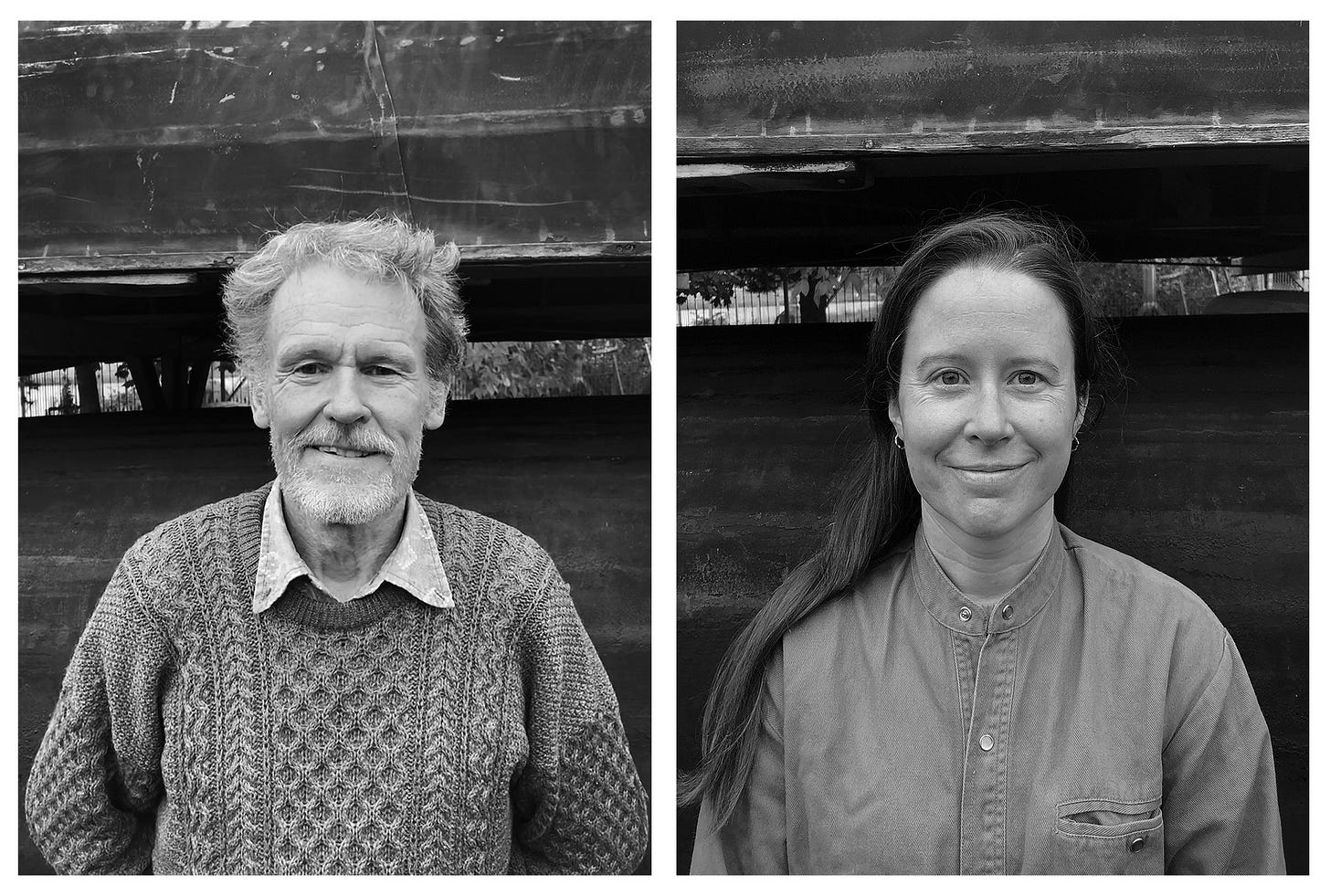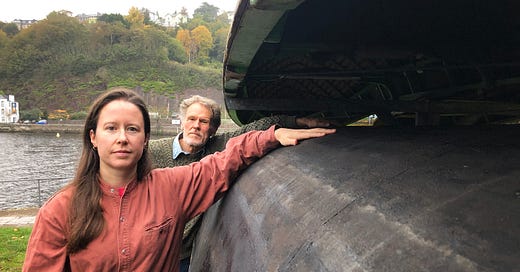"It’s still radical for a 67-year-old man to be dancing on stage with his daughter.”
Dancer Siobhán ní Dhúinnín and her father, boatbuilder and Meitheal Mara founder Pádraig Ó Dúinnín, are taking radical steps with their dance performance exploring tradition, language and family.
For a time in the mid-nineties, the fledgling boat-building social enterprise Meitheal Mara shared a warehouse on the end of Horgan’s Quay with The Everyman Palace Theatre.
While traditional boat-building took place in one half of the warehouse, in another area, cordoned off but accessible to resourceful and bored children, rails of glitzy but moth-eaten costumes sat cheek-by-jowl with the kind of panto props that childhood dreams are made of.
“There was Cinderella’s carriage, all these mouldy dresses,” Siobhán ní Dhúinnín says. “I’m sure they had a dress from My Fair Lady. There was a barrier of course, but we were kids and we got under.”
Siobhán, now 36 and a professional dancer, is explaining how she, a bookish and shy child, was drawn to the world of performance.
“That brought the magic of theatre alive, but I never would have done acting because of not wanting to talk,” she says. “Yet I had this very exciting internal world that I wanted to share with people.”
“I think I was drawn to dance because I was curious about movement, because I was very imaginative and the world of theatre and dance is a place where you can make real your imagination.”
Siobhán has met me to discuss her dance piece, Bád Shiobhán, which premiered online at Cork Midsummer Festival last year, and which is due a new live outing at Uillinn: West Cork Arts Centre in Skibbereen next weekend.
Her childhood, spent amongst boats and on the water as her Gaelgeoir parents worked to bring a new tradition to Cork City, is highly relevant: for Bád Shiobhán, she enlists the help of her father Pádraig in bringing to the stage an exploration of boat-building, language, father-daughter relationships and more.
Not only did Pádraig, now 67, build a boat with his daughter for the piece, he also performs alongside her in it.
Incorporating some spoken elements, video and materials from the boat-building process, the dance is “a father and a daughter working alongside each other with their shared maritime experiences, and through dance, because for me, dance is radical,” Siobhán tells me. “And it’s still radical for a 67-year-old man to be dancing on stage with his daughter.”
With the notable exception of Tanztheater Wuppertal and Pina Bausch’s insistence on working with her dancers throughout the varied stages of their lives, it does still seem radical, or at the very least unusual, for professional dance to showcase older dancers, in part due to the rigours of dance for the body.
“Dad did Five Rhythms dancing for years and he’s a great dancer,” Siobhán says. “I wasn’t easy on him. I made the piece knowing that he has an older body and is not a dancer and has some health issues, but in terms of his commitment of presence, I expected him to be there in the way I would expect a really experienced dancer to commit to a project. And he’s very well able for that, very present.”
A “maverick,” building new traditions
Siobhán describes an unusual childhood growing up bilingual near The Lough in Cork city: her father comes from Coolcower, near Macroom, from an Irish-speaking family. He didn’t speak English until he went to school.
Her mother, in the meantime, grew up in the family that used to own The Gables Bar on Douglas St: they spoke a lot of Irish, but it was learned in school.
The year Siobhán was born, 1986, Pádraig acquired his first Naomhóg: these are the type of Currach built in West Kerry. It was to be a life-changing acquisition.
“He still has that boat,” Siobhán says with a laugh. “When we were rehearsing, he said, ‘and this is the boat I bought in 1986,’ and I said, ‘Dad, what else happened in 1986?’ and he went, ‘Errrrrrrr….’ and I was pointing at myself: me, dad. I happened.”

Naomhógs are now a common sight on the Lee, thanks to Pádraig and Siobhán’s mother and a small community of enthusiasts they built up around them throughout the nineties.
A new tradition for Cork
Today, Meitheal Mara provides community employment from their Crosses’ Green boatyard, the Ocean to City race Pádraig helped found is at the heart of Cork Harbour Festival, and Naomhóga Chorcaí, the rowing club that puts Meitheal Mara’s boats through their paces, are a fixture on the Lee, so timeless that they seem like a tradition unto themselves.
Which they’re actually not, in the context of Cork: “Dad was a bit of a maverick, a Cork inlander going to learn how to build these boats,” Siobhán says.
Siobhán’s childhood, then, was redolent with the smell of resin from planed wood, marked by hours spent mooching in boatyards and rowing the Lee in Currachs. Now, there’s a growing awareness of the river as an amenity, but at the time, this was not the case.
“Boats had become so unusual to see in the city that people would spit from the bridges, drop bottles or bricks,” Siobhán says. “But it was very exciting.”
“In every workshop they had, we were there. I used to do my homework in Crosses’ Green. We were collected from school in a van full of who-knows-who, with a boat on the top: not something a teenager really wants, a parent who shows up in a big van with a big boat on the top.”
“So the boats were really, really entwined with our lives. I did move away from it myself when I was a bit older. But sitting back in a boat is like visiting a grandaunt that you may not see very often, but you know very well.”
In 2017, Pádraig was involved in an accident at sea, one which made headlines and tragically claimed the life of one of the crew. “That was a real reminder that there are things that I would like to learn from him, that could easily be gone,” Siobhán says.
So the following year, when Siobhán started a Rinceoir Cónaitheach (Resident Dancer) residency at the the Cultural Centre in the Gaeltacht of Baile Mhúirne, she began to conceive of Bád Shiobhán.
What has working with her dad done to her relationship with him? “I think it’s allowed me to see him more as a person, and that feels very precious,” she says.
Wait a minute.
The conversation is starting to feel wrong.
I’m asking Siobhán to talk about her dad, but he’s not here. I just….got it wrong: one interview isn’t enough for this article. We arrange to meet again, this time with her dad.
Pádraig
Pádraig Ó Dúinnín’s life is worthy of a documentary: in 1992 he was one of a three-man crew that rowed a little Naomhóg to victory in the Great River Race on the Thames, where over 300 self-propelled craft from all over the world compete annually in the largest rowing race of its kind in the world.
He’s hosted Irish language TV programmes, made innumerable open water voyages, and through his work in bringing Naomhógs to the Lee, made an enormous impact on the landscape of Cork city living.
We meet down at the river where the Naomhógs are stored. They are so like living things to be amongst, we agree: great organic organisms, the canvas stretched like skin over their ribs.
Pádraig remembers a black cow from his childhood near Macroom, where the Lee and Sullane rivers meet. He would lie with his head resting on her flank on a sunny day, her dark hide radiating heat and both of them drowsing in the summer sun.
He leans against the tar-black flank of an upturned Currach, runs his hand along it meditatively.
Recently, he has been involved in an archiving project and has been looking back over photos of Meitheal Mara’s 20 year history. The experience of Bád Shiobhán has also been profoundly thought-inspiring.

“When I’m dancing, it’s like I’m 47,” he says. “I’ve knocked 20 years off, and I can also access 17 again, through the movement. I’m developing a new theory about memory because I’m looking at a lot of photos of Meitheal Mara at the moment. You’re looking at pictures of yourself doing stuff that you can’t do today, and you realise, it’s all still in my body.”
“That experience of crazy, active stuff is still in my body right now. The dance has allowed that to have some kind of reality: it’s all here, in this body.”
The years of work put into Meitheal Mara, into boatbuilding and rowing, he now sees as “manic carry-on, really. It was so manic that I never was able to appreciate it until now, so now the photographs are helping me to work back through all of it.”
When Siobhán asked him to be in her dance piece, he hesitantly accepted. They needed to see how it would sit with them, the idea of performing physically alongside each other as a father and adult daughter, and so they booked a space at Dance Cork Firkin Crane.
“I was concerned about how it would be, so we tried it out in the Firkin Crane, just leaning against each other and moving over and back across the room, just to see would it feel alright,” Pádraig says. “And what made it safe for me was Siobhán’s professionalism. This is all stuff she does routinely, her experience of doing this over a long period of time. There was sufficient distance between us that it didn’t feel dangerous.”
If Gaeilge floats your boat
The Irish language is a foundation stone for the dance piece through Siobhán’s work, as well as for Meitheal Mara.
“Part of the ambition was that the learning of the language would be tied to the activity,” Pádraig tells me. “The language is very important to me and it’s not about nostalgia. It’s a resource that opens a different type of software in your head once you acquire it. It opens another way of looking at the world.”
“In Ireland we are wide open to the whole stream of what’s coming at us from the west of this island, and without another language, you have no context in which to place this storm of information that’s coming at you. If you have Irish, it’s speaking to you from the ground, from the names, from all around you. I have no hesitation in being proud of what I have of that language, and I am interested in others acquiring it too, if that floats their boat.”
Go West
Bringing Bád Shiobhán to West Cork connects the piece to the maritime tradition of Naomhógs: the Cork currachers would have a regular presence at the Baltimore Wooden Boat Festival, would row to islands off the West Cork coast.
For Siobhán, it’s a dance homecoming of sorts because of her long-standing connection to Uillinn: West Cork Arts Centre, where she has had residencies and been involved in a variety of performances.
For Pádraig, there are fond memories of time spent at Hegarty’s Boatyard, just outside Skibbereen on the River Ilen. He describes it as “a special place” with a timeless approach to things: “there’s a bit of ease and good nature in their way of doing things.”
The memories of busy adults and the memories of their children can be very different things.
“Yeah, we would have spent a lot of time hanging around in that boatyard, bored,” Siobhán interjects.
Pádraig turns to her in surprise: “Were you there?” “Loads of times, dad.” “Oh. I thought I was entirely on my own.”
They laugh, father and daughter together, turning towards each other.
Bád Shiobhán will be performed at Uillinn: West Cork Arts Centre in Skibbereen on Friday, October 28 at 8pm. More information here.





